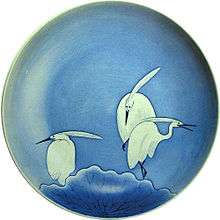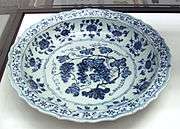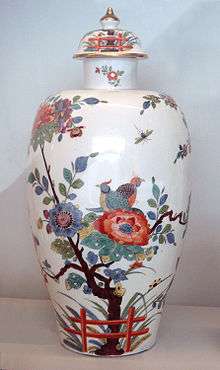Kutani ware

A Kutani ware
ewer with design of lions and peonies.
Kutani ware (九谷焼, Kutani-yaki) is a style of Japanese porcelain first established by Gotō Saijirō, a member of the Maeda clan, who set up a kiln in the village of Kutani (now part of the city of Kaga)[1] on the order of Maeda Toshiharu, ruler of the Kaga domain.[2] The porcelain style is known for multiple colors—such as greens, blues, yellows, purples, and reds—and bold designs covering most of the surface of each piece.[2][3][4]
History
The first time we hear of porcelain from the Kutani (nine valleys) Village, was in 1655, in the first year of the Myoreki epoch. Japanese ceramic history has it that stones suitable for porcelain making was found in the Kutani mine of the Daishoji Clan, whereupon Lord Maeda Toshiharu sent Goto Saijiro to the Arita Village in the Hizen province to learn how to make porcelain. Kutani Porcelains from this early period are specifically called Ko-Kutani and are extremely rare. The production of this ware continued for about 50–60 years.
Kokutani enjoyed popularity for the next few decades until the Kutani suddenly closed down in 1730.[5] The reasons for this closure are debated.[4] Theories put forward include that supplies of the pigments necessary for the glazing were difficult to find, or that there were financial difficulties.[3] This period of production is now referred to as the Old Kutani (古九谷, Kokutani).[1][3]

The site of Old Kutani porcelain kiln (right), the memorial to Gotō Saijirō for Old Kutani ware (left).
In 1810 - some 80 years later - kutaniyaki was re-established, with the help of several kamamoto or production potters. New overglaze painting techniques from various kamamoto-es were infused in the development of kutaniyaki. 6 different overglazing techniques dominate the new form of kutaniyaki: the Mokubei style, influenced by Chinese ink painting techniques. The colours of green, yellow, purple and dark blue form the basis of the Yoshidaya style. Contrasting the Yoshidaya is the Eiraku style, with its simplistic coatings of gold on the first coat of red colour.[5] The Iidaya style, or the Hachirode breaks away from the conventional nature-themed kutani style, with minute paintings of human figures on a red - gold mix background.[6] The Shoza style is a blend of all four techniques of overglazing.[5]
A memorial to Gotō has been erected near an old Kutani ware kiln in the city of Kaga. The style of producing Kutani was named a traditional craft in 1975.[2] There are now several hundred companies which produce Kutani ware.[1]
References
External links
|
|---|
| | China | | |
|---|
| | Korea | |
|---|
| | Japan | |
|---|
| | Europe | |
|---|
| | Technologies | |
|---|
| | People | |
|---|
| | Collections | |
|---|
|




